Watch A Black Hole Tear A Star To Bits In Epic New Animation
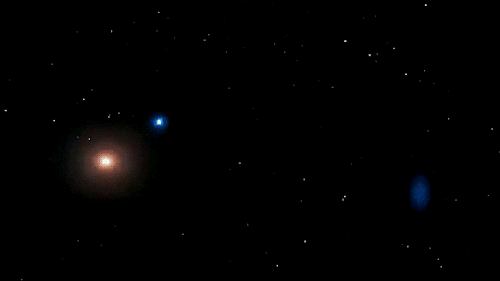
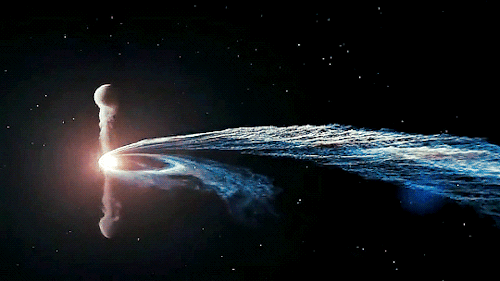
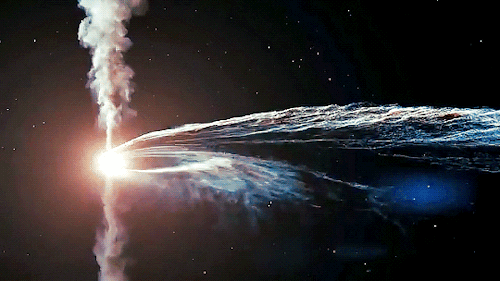
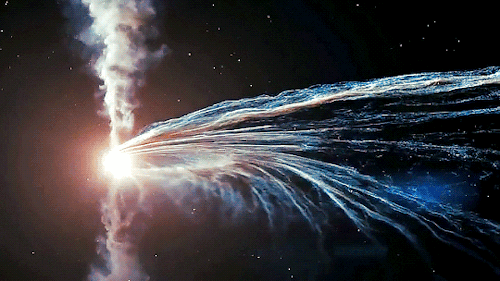
Watch a black hole tear a star to bits in epic new animation
More Posts from Starry-shores and Others

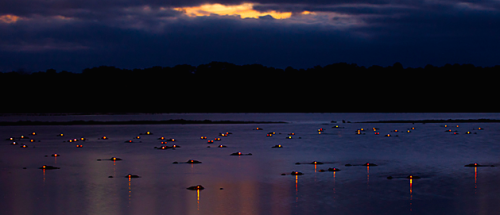


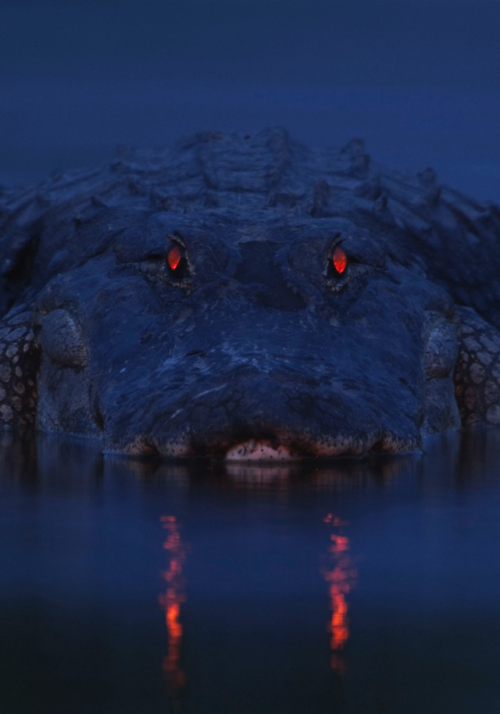
the red eyeshine of the alligator occurs when light enters its eyes, passes through the rods (light receptors) and cones (color receptors) of the retina, strikes a membrane behind the retina called a tapeatum, and is then reflected back through the eye to the light source. most of the animals with eyeshine are, like alligators, night hunters who must make use of limited light. photos by larry lynch and david moynahan

The Aurora Named STEVE by NASA Goddard Photo and Video

MESSIER 56 The NASA/ESA Hubble Space Telescope captured this image of Messier 56 (also known as M 56 or NGC 6779), located about 33,000 light years away from Earth in the constellation of Lyra (The Lyre). The stars in the globular cluster are tightly bound together by gravity.
Keep reading
TOP 10 PREHISTORIC OCEAN PREDATORS

10. ANOMALOCARIS (~ 525 Ma) This one metre long invertebrate surely deserves to be included on the list, being one of the first complex oceanic predators to ever have existed. Anomalocaris stalked the Cambrian oceans, viewing the world with a deadly new evolutionary innovation - eyes. Complex eyes allowed this creature to storm its way to the top of the food chain, and with powerful appendages covered in spines it had no trouble devouring prey with tough carapaces. Whilst Anomalocaris is dwarfed by the other contenders on this list, it was still over 10 times larger than any other animal of its time.

9. KRONOSAURUS (125-99 Ma) Kronosaurus, a Cretaceous mosasaur, is named after the Greek titan, Cronus. Its name is well deserved as this ancient beast was a remarkably powerful being. Kronosaurus could reach up to 10 metres long and had a mouth full of sharp, conical teeth. Unlike most other mosasaurs its tail was relatively short, however, evidence shows that Kronosaurus has immensely powerful fins and a pectoral girdle making it an impressive swimmer and hunter.

8. HELICOPRION (290-250 Ma) Helicoprion has astounded scientists since its discovery over 100 years ago. It is iconic for its bizarre spiral of teeth, there are still debates on where exactly these teeth where on the shark with proposals stating they were inside the mouth, on the tip of the tail, the dorsal fin or hanging under the jaw. The most commonly accepted location of the teeth is inside the lower jaw enabling Helicoprion to cleanly slice its prey into pieces.

7. XIPHACTINUS (~110-70 Ma) Xiphactinus was an extraordinary fish that lived during the Cretaceous. It was an esteemed predator that could reach an incredible 6 metres in length and specimens are renowned for their stunning preservation. One such example was 4 metres long and found with another exceptionally well preserved fish just short of 2 metres inside it implying that this particular Xiphactinus individual died shortly after its last feast. Xiphactinus had immensely sharp, slim teeth and an unmistakable underbite which was a possible aid when snaring creatures from below.

6. TYLOSAURUS (86-75 Ma) Tylosaurus is considered a mosasaur and was a vivacious predator all be it smaller than its relative Mosasaurus. Tylosaurus could reach up to 15 metres in length and was one of the apex predators of its day. Fossilised stomach contents of Tylosaurus contain fish, sharks, turtles and other marine reptiles. Despite having an impressive set of teeth, the frontal areas of the jaws exhibit a large reduction in tooth size as well as a more heavily reinforced snout in comparison to other mosasaurs suggesting that Tylosaurus may have rammed into victims with immense force damaging prey internally.

5. MOSASAURUS (70-66 Ma) The mosasaurs ruled the Cretaceous oceans and Mosasaurus was no exception. It could reach up to 17 metres long, longer than most other mosasaurs. Mosasaurus had a strong jaw packed with numerous conical teeth, bite marks of which have been found in huge prehistoric turtles and ammonites suggesting that Mosasaurus was a formidable hunter capable of catching large prey. Mosasaurus was a profound swimmer with strong paddle-like limbs and a huge tail capable of rapidly accelerating the animal when required.

4. DUNKLEOSTEUS (382-358 Ma) Dunkleosteus terrorised the oceans around 370 million years ago and was part of a dynasty known as the placoderm fish (meaning armoured). Dunkleosteus could reach a whopping 6-10 metres in length and probably weighed over a ton. The skull was made up of huge, solid bony plates giving unrivalled protection allowing them to dominate the oceans. Placoderm fish were some of the first organisms to have a mobile jaw, as can be seen in Dunkleosteus’ impressive shearing plates which were used to slice cleanly through prey. Despite an revolutionary jaw, Dunkleosteus could not chew and several fossilised regurgitated remains of its meals have been found that the giant fish simply could not stomach.

3. DAKOSAURUS (157-137 Ma) Dakosaurus was the largest of a group of marine reptiles that were distant relatives of crocodiles. Dakosaurus could reach up to 5 metres long and had a streamlined body with large paddle-like fins and a long muscular tail implying that is was a very efficient swimmer. The diet of Dakosaurus consisted mostly of fish. The teeth of Dakosaurus are lateromedially compressed and serrated which is a similar morphology to modern killer whales indicating that Dakosaurus was an apex predator of the Jurassic oceans. Skull fenestrae provides evidence that Dakosaurus had very large adductor muscles (which are responsible for the jaw closing) and so it was certainly capable of a forceful bite.

2. LIOPLEURODON (160-155 Ma) Liopleurodon stormed the Jurassic oceans, its huge 7 metre long frame effortlessly cruised through the water. The skull itself could reach a massive 1.5 metres long with a jaw that was packed with teeth up to 10cm long and was capable of an immense bone-crushing force. Liopleurodon was a remarkable hunter with the ability to swim with its nostrils open and so could use its powerful sense of smell to track prey from afar, much like sharks do. Liopleurodon most likely had good camouflage such as a lighter underside and a darker topside so it would blend in with the water to prey above and below.

1. MEGALODON (~16-2.6 Ma) Megalodon rightfully deserves the top position of the greatest prehistoric ocean predators, ruling the seas for an incredible 14 million years. Megalodon has been estimated to reach up to 18 metres in length and weighing over 40 tonnes. Megalodon is known for its huge 6 inch teeth which were serrated on both sides for an efficient slicing action. Fossils of Megalodon’s prey have also been found, the shark appeared to have adapted its hunting tactics for different sized prey; for smaller prey they would just use their bone crushing bite to pulverise internal organs, but for larger prey they would bite or rip flippers off of creatures to immobilise them and then go in for the kill. The exact bite force of Megalodon has been estimated at around 110,000 N which was more than enough to shatter even the most robust bones. The hunting methods of Megalodon will unfortunately remain a mystery but it was been hypothesised that they swam at great depths and used short bursts of speed to swim up and tear into their preys vulnerable underbelly. Sharks have existed for over 420 million years and still continue to be some of the most successful predators alive, Megalodon is a perfect example of how deadly they can be.
RECORD BREAKERS
Life on earth, as magnificent and versatile as it is, is seemingly tame compared to the weird and wonderful creatures that once existed. All categories of life have reached unimaginable sizes, here are just a selection of prehistoric record breakers!

MEGALODON The biggest shark known to have existed, ruling over the oceans as recently as up to a million years ago. A length of almost 20 metres and weighing in at an estimated 48 tonnes, Megalodon could deliver a crucifying bite of up to 110,000N. It is no surprise that the Megalodon was dubbed the “whale killing shark”.
MEGATHERIUM Our early ancestors would have been quite familiar with Megatherium as they existed up to 8000 years ago, they were in fact the largest sloths to have existed. Sloths have a reputation as being lazy, slow and docile, but Megatherium was a 6 metre long, 4 tonne monster with a killer instinct and knife-like claws. Megatherium’s discovery came before that of the dinosaurs. Skeletons of these prehistoric beasts were a delight to the Victorian public and paved the way for the science of palaeontology.

ARCHELON Literally meaning “large turtle”, Archelon certainly was just that. Existing during the cretaceous, the time of the dinosaurs, Archelon could reach 4.5 metres long and may have lived to over 100 years old. Archelon could not compete with other cretaceous beings in speed and agility, but its blade-like beak was able to slice through flesh and crush though the toughest ammonite shells. Unfortunately Archelon appears to have been a popular snack for other marine dwellers, skeletons are frequently missing flippers or heads and covered in slashes.
TITANOBOA When the dinosaurs reign ended, a new era saw the rise of new super-predators, one was Titanoboa, the largest snake ever with a body up to 13 metres long, standing a metre off the ground and weighing up to 2500 pounds. Titanoboa was 30% longer than even todays largest species. Scientists believe this humongous snake hunted like its modern relatives, the boa constrictors, by winding around prey and suffocating them.

IRISH ELK Owner of the largest antlers of any animal, up to 3 metres wide, the Irish Elk gets its name from its frequent discoveries in Irish peat bogs. Existing up to 10,000 years ago, these would have been a common sight in grasslands for our ancestors. Many fossils indicate the animals died of starvation which is why the antlers are thought to have been part of elaborate mating contests between males, often resulting in one being fatally injured and unable to feed itself.
DEINOTHERIUM A distant relative of the elephants and mammoths, Deinotherium was more sinister, its name translates to “terrible beast”, they would have most likely caused trouble for our ancient ancestors around 1.5 million years ago. Deinotherium is actually considered to be the second largest land mammal of all time, behind Paraceratherium and is iconic in appearance due to its sharp, downward facing tusks.
ARCTODUS Known as the short faced bear, they were the biggest bears on record and one of the largest mammal carnivores to have existed. Whilst their skull was short, they were packed with piercing teeth that could deliver a bone crushing bite. Existing up to 11,000 years ago, out ancestors would have stayed well clear of this 900 kilogram predator, with slender limbs and knife-like claws, Arctodus was deadly.

SARCOSUCHUS One of the most infamous fossil discoveries in history, Sarcosuchus was the largest crocodile to walk the Earth up to 112 million years ago, this was a crocodile capable of killing dinosaurs. Sarcosuchus was twice as long as a saltwater crocodile, that’s 11-12 metres long and could reach over 8 tonnes. Its jaw was packed full of 66 teeth either side of its jaw and would have clamped down on prey that wandered too near.
ARGENTINOSAURUS One of the largest lifeforms that has ever stood on the Earth, Argentinosaurus could grow up to 30 metres long with its hind limbs standing 4.5 metres off the ground. They existed between 97-94 million years ago and at adulthood would have been virtually indestructible to predators. Its weight is estimated at a staggering 80-100 tonnes. There hasn’t been another land mammal on the same scale as Argentinosaurus since and it’s unlikely there ever will be.

SPINOSAURUS The largest discovered therapod ever, a group that includes Allosaurus and Tryrannosaurus. Spinosaurus remained an enigma to scientists for decades, the only discovered specimen was sadly destroyed during World War 2 and was not rediscovered until the 21st century. Spinosaurus is thought to have reached up to 16 metres long and weighed in around 12 tonnes, that is almost double the weight of a T-rex!
cosiscience
Walking dinosaur, Columbus Interactive Science Museum
-
 untitleduntilretitled liked this · 3 weeks ago
untitleduntilretitled liked this · 3 weeks ago -
 freelyhoney liked this · 3 weeks ago
freelyhoney liked this · 3 weeks ago -
 lordflackorudy2 reblogged this · 3 weeks ago
lordflackorudy2 reblogged this · 3 weeks ago -
 isettrendz liked this · 3 weeks ago
isettrendz liked this · 3 weeks ago -
 rajahindustanii liked this · 3 weeks ago
rajahindustanii liked this · 3 weeks ago -
 saygodj liked this · 3 weeks ago
saygodj liked this · 3 weeks ago -
 urangeltho liked this · 3 weeks ago
urangeltho liked this · 3 weeks ago -
 goddess4444xo reblogged this · 3 weeks ago
goddess4444xo reblogged this · 3 weeks ago -
 goddess4444xo liked this · 3 weeks ago
goddess4444xo liked this · 3 weeks ago -
 thebbandflow reblogged this · 3 weeks ago
thebbandflow reblogged this · 3 weeks ago -
 thebbandflow liked this · 3 weeks ago
thebbandflow liked this · 3 weeks ago -
 loyally-shamona liked this · 3 weeks ago
loyally-shamona liked this · 3 weeks ago -
 the3st reblogged this · 3 weeks ago
the3st reblogged this · 3 weeks ago -
 basquiat11 reblogged this · 3 weeks ago
basquiat11 reblogged this · 3 weeks ago -
 samosapow2 reblogged this · 3 weeks ago
samosapow2 reblogged this · 3 weeks ago -
 thelastronin09 reblogged this · 3 weeks ago
thelastronin09 reblogged this · 3 weeks ago -
 hitzmyblunt2 reblogged this · 3 weeks ago
hitzmyblunt2 reblogged this · 3 weeks ago -
 eljefe94 reblogged this · 3 weeks ago
eljefe94 reblogged this · 3 weeks ago -
 call-1993x reblogged this · 3 weeks ago
call-1993x reblogged this · 3 weeks ago -
 j-westend liked this · 3 weeks ago
j-westend liked this · 3 weeks ago -
 j-westend reblogged this · 3 weeks ago
j-westend reblogged this · 3 weeks ago -
 kmelli reblogged this · 3 weeks ago
kmelli reblogged this · 3 weeks ago -
 ariellabelle liked this · 3 weeks ago
ariellabelle liked this · 3 weeks ago -
 west-erie reblogged this · 3 weeks ago
west-erie reblogged this · 3 weeks ago -
 west-erie liked this · 3 weeks ago
west-erie liked this · 3 weeks ago -
 trxllionaire reblogged this · 3 weeks ago
trxllionaire reblogged this · 3 weeks ago -
 on4theride reblogged this · 3 weeks ago
on4theride reblogged this · 3 weeks ago -
 on4theride liked this · 3 weeks ago
on4theride liked this · 3 weeks ago -
 akadoodoo liked this · 3 weeks ago
akadoodoo liked this · 3 weeks ago -
 saturnsgoat reblogged this · 3 weeks ago
saturnsgoat reblogged this · 3 weeks ago -
 91since91 liked this · 3 weeks ago
91since91 liked this · 3 weeks ago -
 housemafia reblogged this · 3 weeks ago
housemafia reblogged this · 3 weeks ago -
 housemafia liked this · 3 weeks ago
housemafia liked this · 3 weeks ago -
 yocola liked this · 3 weeks ago
yocola liked this · 3 weeks ago -
 yocola reblogged this · 3 weeks ago
yocola reblogged this · 3 weeks ago -
 92till liked this · 3 weeks ago
92till liked this · 3 weeks ago -
 m3ybuz reblogged this · 3 weeks ago
m3ybuz reblogged this · 3 weeks ago -
 itsadamnbeehive liked this · 3 weeks ago
itsadamnbeehive liked this · 3 weeks ago -
 de-putx-madre liked this · 3 weeks ago
de-putx-madre liked this · 3 weeks ago -
 mayorofpoundtown reblogged this · 3 weeks ago
mayorofpoundtown reblogged this · 3 weeks ago -
 cheynoellee reblogged this · 3 weeks ago
cheynoellee reblogged this · 3 weeks ago -
 slumsaintt reblogged this · 3 weeks ago
slumsaintt reblogged this · 3 weeks ago -
 krustyspacepimpadventurediary reblogged this · 1 month ago
krustyspacepimpadventurediary reblogged this · 1 month ago -
 swampd0nkey liked this · 1 month ago
swampd0nkey liked this · 1 month ago -
 villalunae liked this · 1 month ago
villalunae liked this · 1 month ago -
 de-putx-madre reblogged this · 1 month ago
de-putx-madre reblogged this · 1 month ago -
 someonessw liked this · 1 month ago
someonessw liked this · 1 month ago -
 shannybangbang reblogged this · 1 month ago
shannybangbang reblogged this · 1 month ago

Amateur astronomer, owns a telescope. This is a side blog to satiate my science-y cravings! I haven't yet mustered the courage to put up my personal astro-stuff here. Main blog : @an-abyss-called-life
212 posts









